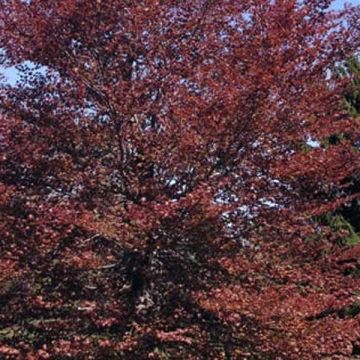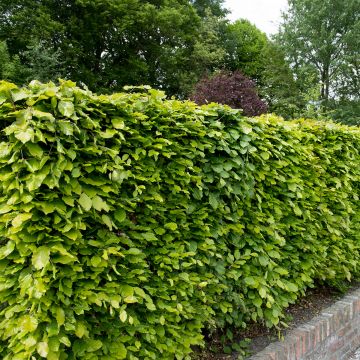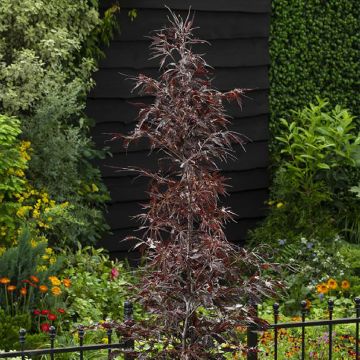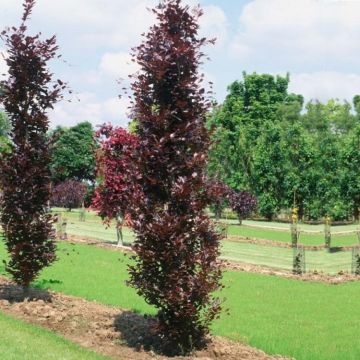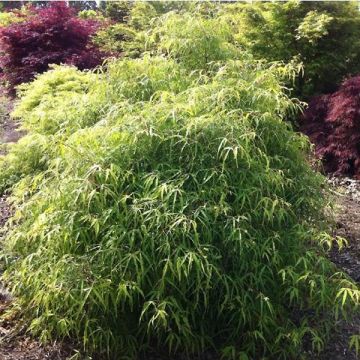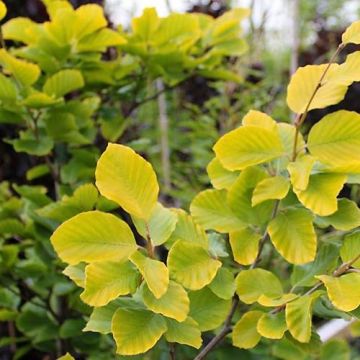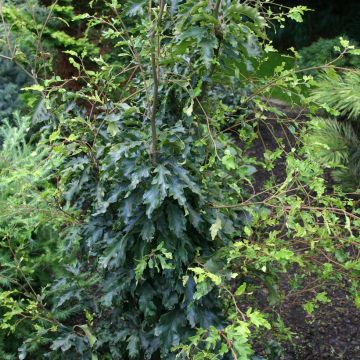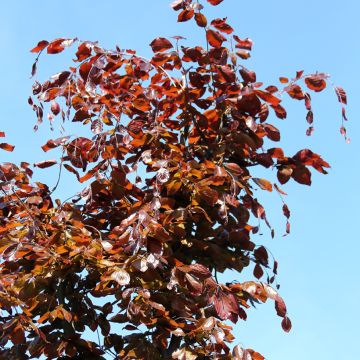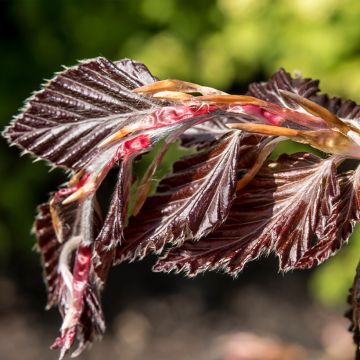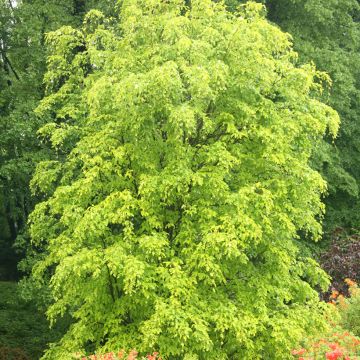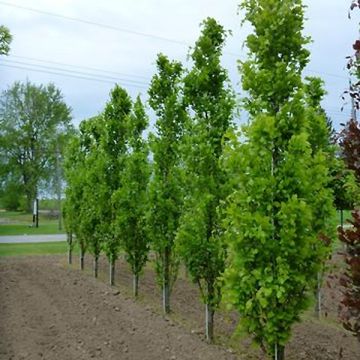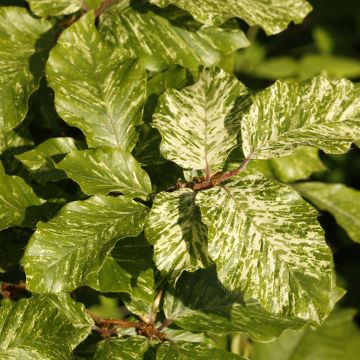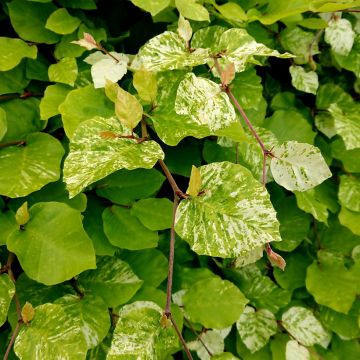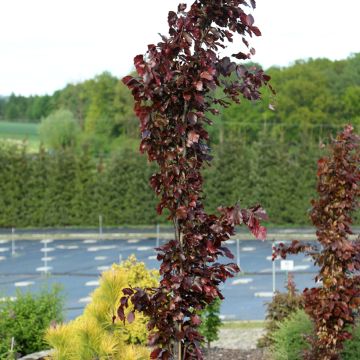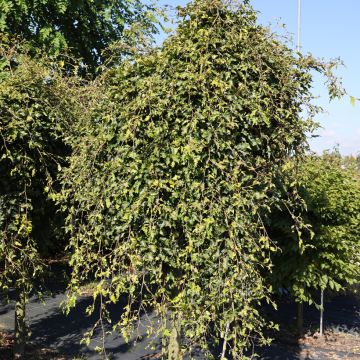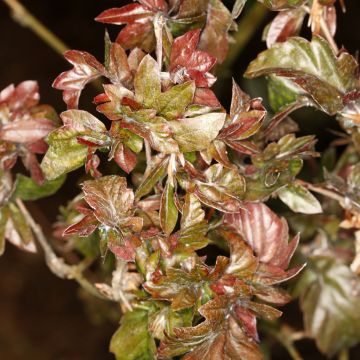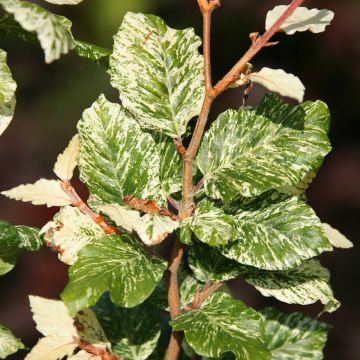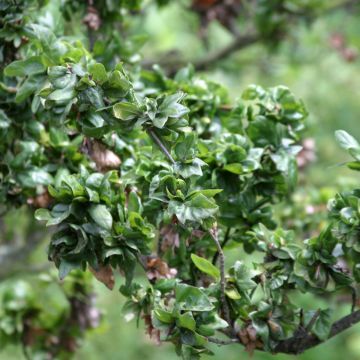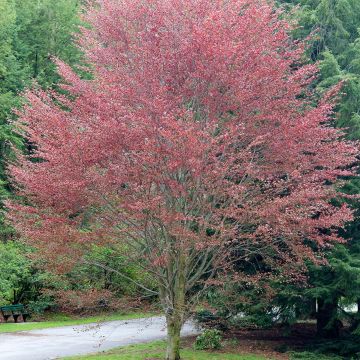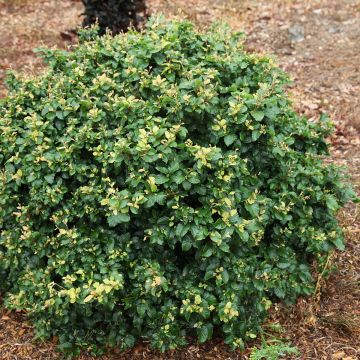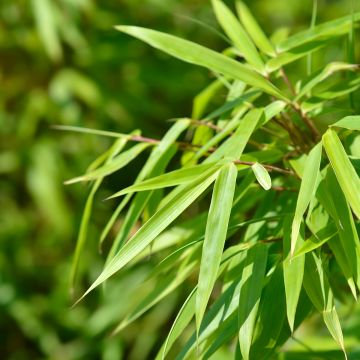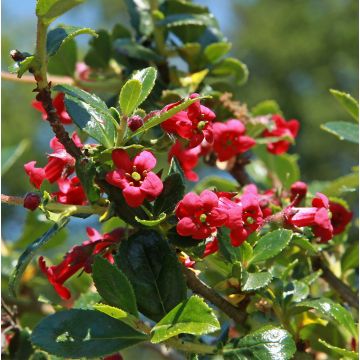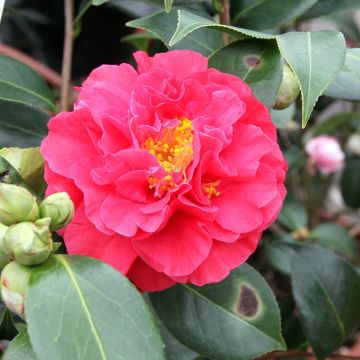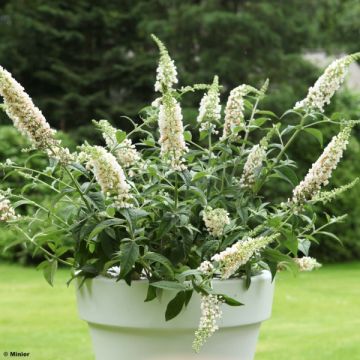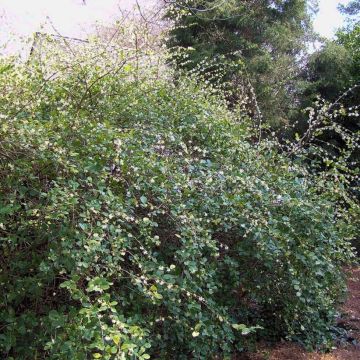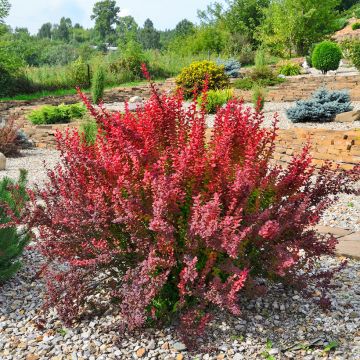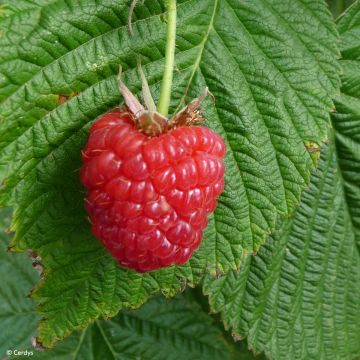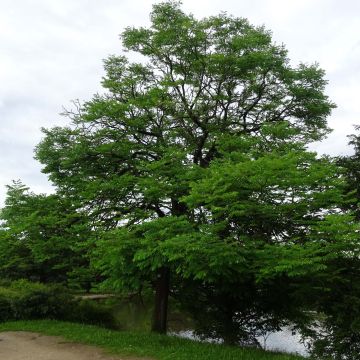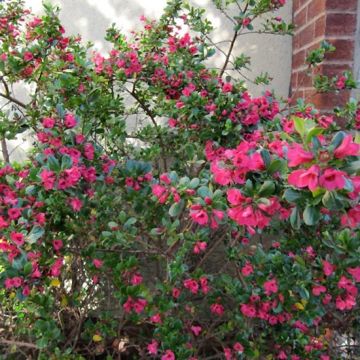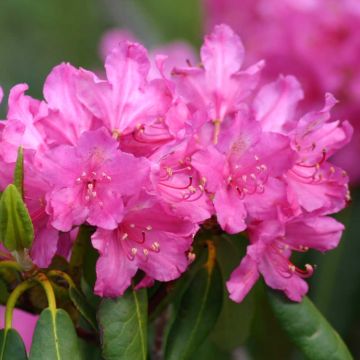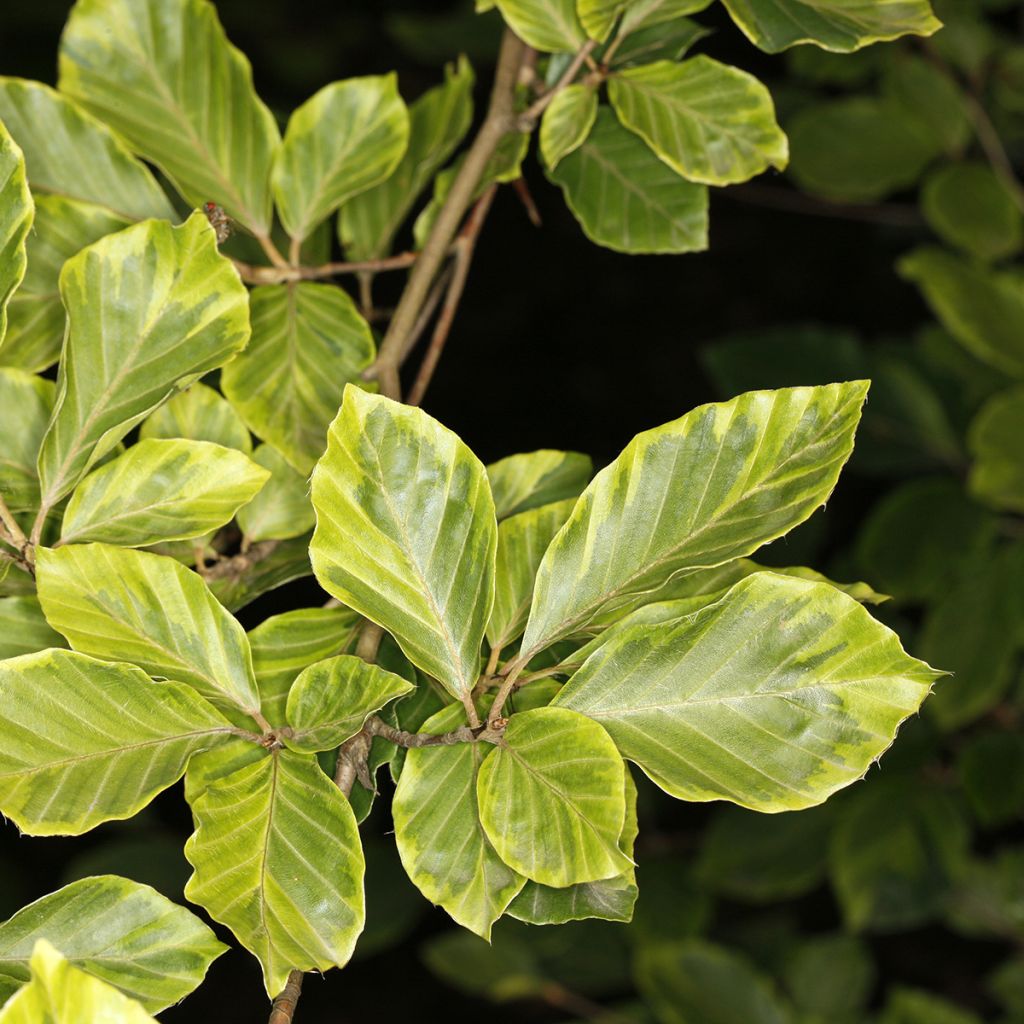

Fagus sylvatica Luteovariegata - Beech
Fagus sylvatica Luteovariegata - Beech
Fagus sylvatica Luteovariegata
European Beech, Common Beech
Why not try an alternative variety in stock?
View all →This plant carries a 24 months recovery warranty
More information
We guarantee the quality of our plants for a full growing cycle, and will replace at our expense any plant that fails to recover under normal climatic and planting conditions.
From €5.90 for pickup delivery and €6.90 for home delivery
Express home delivery from €8.90.
Does this plant fit my garden?
Set up your Plantfit profile →
Description
Fagus sylvatica 'Luteovariegata' is a tall tree reaching 15 to 20 m in height. It is recognisable by its colourful foliage and graceful silhouette. Its leaves are variegated with golden yellow on a darker green, which fades to light green in summer. Its grey, smooth bark is very attractive. It is also highly appreciated for its dense marcescent brownish foliage, which remains on the branches until spring. With a long lifespan, this beautiful tree deserves a prime location to become a notable specimen in the garden.
Fagus sylvatica, commonly known as common beech, is a species of deciduous trees native to Europe and belongs to the Fagaceae family, like oak and chestnut. It is one of the main forest species in deciduous temperate forests in Europe. It is found in pure beech forests and, more often, with other species in leafy forests, mainly with the English oak or in mixed forests with silver fir or common spruce. It is an indication of a humid temperate climate. Foresters use it to produce timber for furniture and, in mountain areas, for firewood.
The 'Luteovariegata' variety, whose origin is quite unknown, was first described in England around 1770. Lutea or Luteo comes from the Latin word luteus, which means yellow. This very old variety can live for a long time. It forms a slender tree with a straight trunk and a conical to oval crown when young, spreading more as it ages. It has normal growth, but slower than the species, reaching 15 to 20 m in height with a spread of approximately 6 to 10 m at maturity. In an optimal environment, its growth can reach up to 25 m in height. The branches are smooth and greyish. The leaves are alternate, petiolate, ovate, 5 to 10 cm long and wavy on the leaf margin. In spring, they are light green to medium green in the centre, variegated and marginated with yellow, gradually turning more greenish throughout summer. In autumn, the foliage takes on yellowish-brown hues and remains on the tree in winter, only falling when new leaves appear. In spring, around April-May, there are discreet and quite insignificant flowers. The male flowers, grouped in pendulous catkins of 40 to 60 mm, are pale yellow, while the green female flowers are grouped in 2 to 4 at the end of the branches. In autumn, the beech nuts, which are the fruits of the beech, begin to appear in bristly woody husks.
The Yellow Variegated Beech is a robust and cold-resistant tree, down to -30°C. Its silhouette and colourful foliage add a touch of originality to the landscape. It can be planted alone or in groups, for filtered shade or to add colour to the garden. It thrives in slightly acidic to alkaline, deep, well-drained, and humus-rich soils. A sunny exposure is preferable, although a slightly shaded area is tolerated. Beware, stagnant water or lack of water can cause leaf burn in hot weather. Its shallow root system excludes any planting at its base. It is perfect for large lawns, parks, streets, squares, and gardens, but not for small areas.
Report an error about the product description
Plant habit
Flowering
Foliage
Botanical data
Fagus
sylvatica
Luteovariegata
Fagaceae
European Beech, Common Beech
Central Europe
Other Fagus - Beech
Planting and care
Plant Fagus sylvatica Luteovariegata in autumn or spring, choose a sunny but not scorching location, where the soil is deep, and keep in mind the space it will take up in the long term. If necessary, create a drainage pit with stones if your soil is suffocating. If your soil is poor, adding leaf compost will be beneficial. Maintain regular watering during the summer following planting and make sure to protect it from prolonged droughts for another year, mulching can help keep the base moist and space out watering. Remember that this tree needs consistently moist soil, at least at depth. It is perfectly frost-resistant. In February-March, when the tree is dormant, prune to balance the shape of the tree by aerating the centre of the canopy every 3 years or so. Beware of aphids, scale insects, and mildew.
Planting period
Intended location
Care
This item has not been reviewed yet - be the first to leave a review about it.
Hedge shrubs
Haven't found what you were looking for?
Hardiness is the lowest winter temperature a plant can endure without suffering serious damage or even dying. However, hardiness is affected by location (a sheltered area, such as a patio), protection (winter cover) and soil type (hardiness is improved by well-drained soil).

Photo Sharing Terms & Conditions
In order to encourage gardeners to interact and share their experiences, Promesse de fleurs offers various media enabling content to be uploaded onto its Site - in particular via the ‘Photo sharing’ module.
The User agrees to refrain from:
- Posting any content that is illegal, prejudicial, insulting, racist, inciteful to hatred, revisionist, contrary to public decency, that infringes on privacy or on the privacy rights of third parties, in particular the publicity rights of persons and goods, intellectual property rights, or the right to privacy.
- Submitting content on behalf of a third party;
- Impersonate the identity of a third party and/or publish any personal information about a third party;
In general, the User undertakes to refrain from any unethical behaviour.
All Content (in particular text, comments, files, images, photos, videos, creative works, etc.), which may be subject to property or intellectual property rights, image or other private rights, shall remain the property of the User, subject to the limited rights granted by the terms of the licence granted by Promesse de fleurs as stated below. Users are at liberty to publish or not to publish such Content on the Site, notably via the ‘Photo Sharing’ facility, and accept that this Content shall be made public and freely accessible, notably on the Internet.
Users further acknowledge, undertake to have ,and guarantee that they hold all necessary rights and permissions to publish such material on the Site, in particular with regard to the legislation in force pertaining to any privacy, property, intellectual property, image, or contractual rights, or rights of any other nature. By publishing such Content on the Site, Users acknowledge accepting full liability as publishers of the Content within the meaning of the law, and grant Promesse de fleurs, free of charge, an inclusive, worldwide licence for the said Content for the entire duration of its publication, including all reproduction, representation, up/downloading, displaying, performing, transmission, and storage rights.
Users also grant permission for their name to be linked to the Content and accept that this link may not always be made available.
By engaging in posting material, Users consent to their Content becoming automatically accessible on the Internet, in particular on other sites and/or blogs and/or web pages of the Promesse de fleurs site, including in particular social pages and the Promesse de fleurs catalogue.
Users may secure the removal of entrusted content free of charge by issuing a simple request via our contact form.
The flowering period indicated on our website applies to countries and regions located in USDA zone 8 (France, the United Kingdom, Ireland, the Netherlands, etc.)
It will vary according to where you live:
- In zones 9 to 10 (Italy, Spain, Greece, etc.), flowering will occur about 2 to 4 weeks earlier.
- In zones 6 to 7 (Germany, Poland, Slovenia, and lower mountainous regions), flowering will be delayed by 2 to 3 weeks.
- In zone 5 (Central Europe, Scandinavia), blooming will be delayed by 3 to 5 weeks.
In temperate climates, pruning of spring-flowering shrubs (forsythia, spireas, etc.) should be done just after flowering.
Pruning of summer-flowering shrubs (Indian Lilac, Perovskia, etc.) can be done in winter or spring.
In cold regions as well as with frost-sensitive plants, avoid pruning too early when severe frosts may still occur.
The planting period indicated on our website applies to countries and regions located in USDA zone 8 (France, United Kingdom, Ireland, Netherlands).
It will vary according to where you live:
- In Mediterranean zones (Marseille, Madrid, Milan, etc.), autumn and winter are the best planting periods.
- In continental zones (Strasbourg, Munich, Vienna, etc.), delay planting by 2 to 3 weeks in spring and bring it forward by 2 to 4 weeks in autumn.
- In mountainous regions (the Alps, Pyrenees, Carpathians, etc.), it is best to plant in late spring (May-June) or late summer (August-September).
The harvesting period indicated on our website applies to countries and regions in USDA zone 8 (France, England, Ireland, the Netherlands).
In colder areas (Scandinavia, Poland, Austria...) fruit and vegetable harvests are likely to be delayed by 3-4 weeks.
In warmer areas (Italy, Spain, Greece, etc.), harvesting will probably take place earlier, depending on weather conditions.
The sowing periods indicated on our website apply to countries and regions within USDA Zone 8 (France, UK, Ireland, Netherlands).
In colder areas (Scandinavia, Poland, Austria...), delay any outdoor sowing by 3-4 weeks, or sow under glass.
In warmer climes (Italy, Spain, Greece, etc.), bring outdoor sowing forward by a few weeks.

































